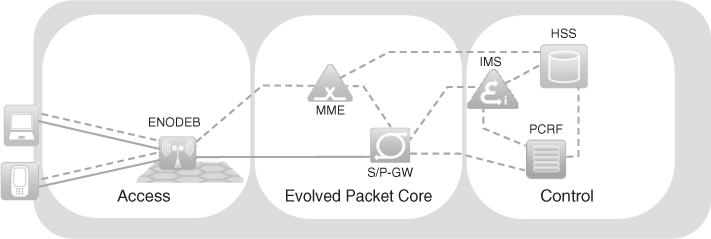Chapter 3
VoLTE System Architecture
3.1 Overview
This chapter introduces the reader to the voice over long term evolution (VoLTE) system architecture. This includes various network entities, how they interact with each other via different reference points. In this book we split architecture into three domains: access, evolved packet core (EPC) and control, as shown in Figure 3.1.
Figure 3.1 VoLTE system architecture.

Figure 3.1 reveals that access contains only one network element, the so-called evolved NodeB (eNodeB or eNB). In previous third generation partnership project (3GPP) radio architectures two networks elements were defined: (i) NodeB and radio network controller (RNC) in the UMTS terrestrial radio access network (UTRAN) and (ii) base transceiver station (BTS) and base station controller (BSC) in the GSM/EDGE radio access network (GERAN). The main reasons for this simplified architecture were reducing complexity, latency and costs while increasing data throughput which we will further explain in Section 3.2.
The EPC consists basically of three functional elements. The first one is the mobility management entity (MME) that resides in the control plane of EPC. The MME can be seen as an evolution of the serving GPRS support node (SGSN) control plane function in the general packet radio system (GPRS). The serving gateway (S-GW) correlates with the SGSN user plane function ...

